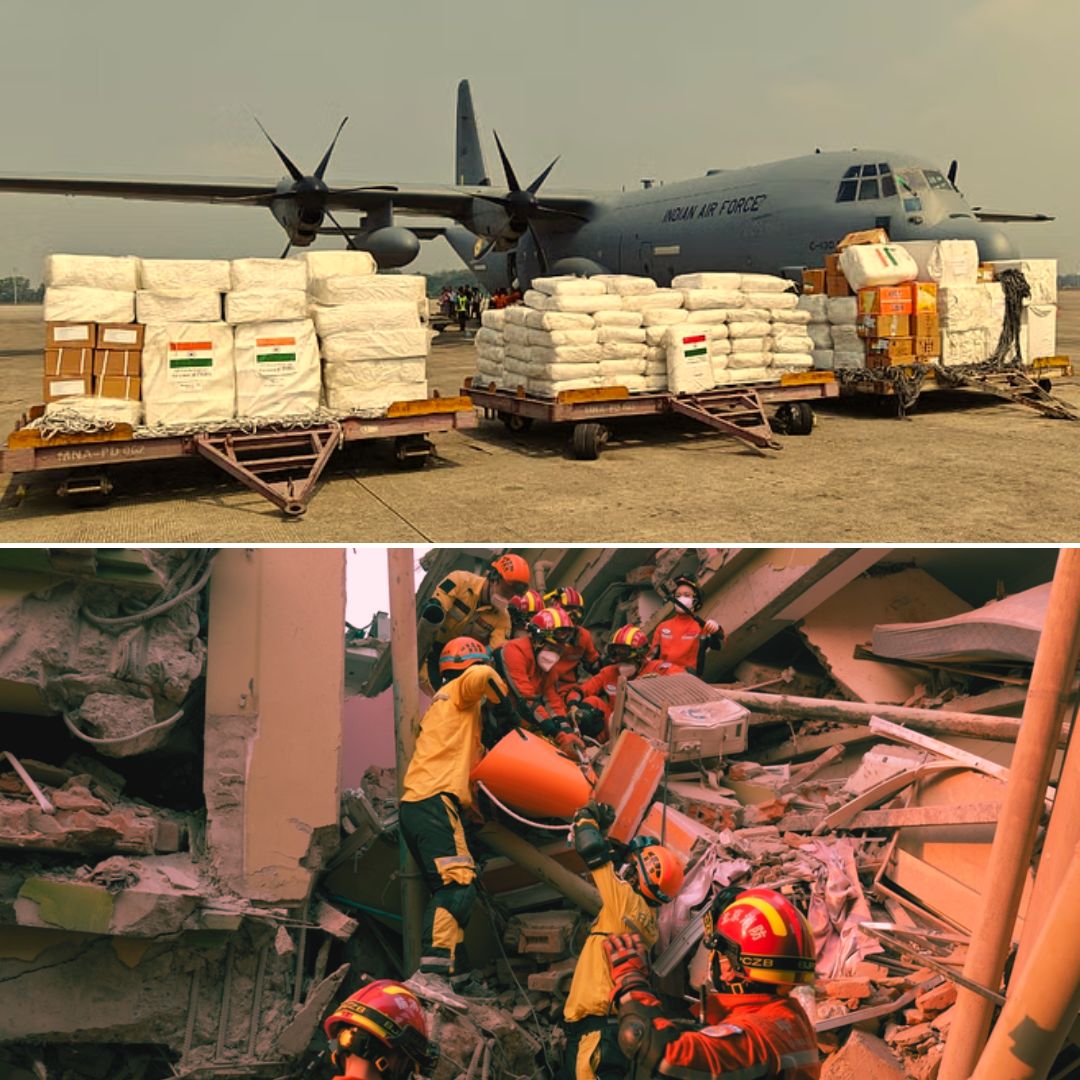Myanmar was struck by a catastrophic 7.7 magnitude earthquake on March 28, 2025, leaving at least 2,056 dead and over 3,900 injured, with thousands still missing. The epicentre was near Mandalay, and the shallow depth of the quake amplified its destructive impact.
Rescue operations are underway, but ongoing civil unrest and military restrictions have hampered access to affected areas. Nations across the globe—including China, India, the United States, and others—have mobilised aid efforts ranging from financial assistance to search and rescue teams.
The World Health Organization (WHO) has declared the situation a top-level emergency and is urgently seeking $8 million to prevent disease outbreaks among survivors.
International Community Rallies to Support Myanmar
The devastating earthquake in Myanmar has triggered an outpouring of international support as countries step forward with aid packages, rescue teams, and humanitarian assistance. Here’s how nations are responding:
1. China
China has been one of the most proactive responders to Myanmar’s crisis. It dispatched an 82-member rescue team equipped with advanced search-and-rescue technology, followed by another contingent of 118 personnel. The Chinese government pledged $13.77 million in aid, which includes tents, blankets, medical kits, and food supplies.
On March 30, China sent 17 trucks loaded with shelter materials and medical supplies to Mandalay. A spokesperson for China’s Ministry of Emergency Management stated, “We are committed to assisting our neighbour in every possible way during this tragedy.”
Around 400 Chinese rescuers, experts, and medical teams are working day and night in Myanmar after the earthquake!
— Dominic Lee 李梓敬 (@dominictsz) April 1, 2025
So far, they’ve saved six survivors. 🇨🇳China moves fast when help is needed. pic.twitter.com/NE7ZAIJGei
2. India
India launched Operation Brahma, deploying two naval ships—INS Satpura and INS Savitri—with an initial shipment of 50 tonnes of humanitarian assistance that included shelter materials and medical supplies. Three additional ships carrying over 500 tonnes of aid are en route to Myanmar.
India also sent a specialised search-and-rescue team equipped with trained dogs and advanced technology to locate survivors trapped under rubble. Indian External Affairs Minister S. Jaishankar expressed solidarity with Myanmar, stating, “India stands shoulder-to-shoulder with its neighbour during this difficult time.”
#OperationBrahma gets underway.
— Dr. S. Jaishankar (@DrSJaishankar) March 29, 2025
First tranche of humanitarian aid from India has reached the Yangon Airport in Myanmar.
🇮🇳 🇲🇲 pic.twitter.com/OmiJLnYTwS
3. United States
The United States committed $2 million through local humanitarian organisations to provide immediate relief such as food, water, and medical supplies.
The U.S. Agency for International Development (USAID) is coordinating efforts with non-governmental organisations (NGOs) on the ground to ensure aid reaches those most affected by the disaster. A team of disaster response experts is being deployed to assist in rescue operations.
4. Vietnam
Vietnam has sent an 80-member earthquake relief team to Yangon, along with a separate 26-member team from its Ministry of Public Security that began search-and-rescue operations in Sagaing city on March 31. Vietnam also announced an emergency aid package worth $300,000 to support recovery efforts in Myanmar.
5. Thailand
Thailand mobilised a 49-member search-and-rescue team while pledging $2 million in financial aid for relief operations. Thai officials are working closely with NGOs to facilitate effective distribution of resources in affected areas near the border regions shared by both countries.
6. South Korea
South Korea pledged $2 million in humanitarian aid and sent emergency relief items such as blankets and food supplies through its embassy in Myanmar.
7. Japan
Japan announced $4 million in emergency funds aimed at immediate relief efforts and dispatched disaster response experts to collaborate with local authorities in assessing damage and coordinating aid distribution effectively.
8. Russia
Russia deployed two aircraft carrying 120 doctors and rescue personnel along with medical supplies to assist survivors and provide healthcare support in affected areas. Russian officials have expressed their willingness to offer further assistance if required.
9. Singapore
Singapore’s Civil Defence Force dispatched an 80-member team trained in urban search-and-rescue operations to assist Myanmar authorities in locating survivors trapped under collapsed buildings.
Background on the Crisis
The earthquake struck at approximately 12:50 PM local time on March 28 near Mandalay at a depth of just 10 kilometres (6 miles), making it particularly devastating due to its shallow origin. Entire neighbourhoods have been flattened, leaving thousands homeless or displaced.
The ongoing civil unrest following Myanmar’s military coup in 2021 has complicated rescue operations significantly; military restrictions have limited access for international aid teams trying to reach remote areas hardest hit by the quake.
As of March 31, reports indicate over 3,900 injuries alongside the confirmed death toll of 2,056—figures that are expected to rise as more bodies are recovered from rubble across cities like Mandalay and Sagaing. Survivors face dire conditions due to shortages of clean water, food, shelter materials, and medical supplies such as trauma kits and blood bags.
The World Health Organization (WHO) declared the situation a top-level emergency on March 30 and urgently appealed for $8 million in funding to prevent disease outbreaks among survivors living in overcrowded camps without access to proper sanitation or healthcare facilities.
The Logical Indian’s Perspective
The Logical Indian strongly advocates for global solidarity during times of crisis like this earthquake in Myanmar. We commend the swift action taken by nations around the world but urge them to ensure that aid is distributed equitably across all affected regions—especially those hardest hit yet most difficult to access due to political or logistical barriers.
This tragedy serves as a reminder that natural disasters know no borders; they demand cooperation rooted in empathy and kindness regardless of political differences or conflicts.
How can we collectively ensure that our global response fosters long-term recovery while addressing systemic issues like poverty and displacement exacerbated by such events? We invite our readers to share their thoughts on how we can build a more resilient world together.
#OperationBrahma 🇮🇳🇲🇲
— NDRF 🇮🇳 (@NDRFHQ) March 29, 2025
01 self-contained Heavy Urban Search & Rescue (USAR) team comprising 80 skilled rescuers including 04 canines, specialized equipment and tools being airlifted for Nay Pyi Taw, Myanmar in two sorties for #SAR operations in earthquake-affected regions. pic.twitter.com/xuHIiYC3xS
4 survivors have been saved by Chinese rescue team in Mandalay, Myanmar. Rescue efforts continue at full speed! pic.twitter.com/r8dY2l2UEC
— Yu Jing (@ChinaSpox_India) March 31, 2025
First pictures of India's field hospital in Mandalay, Myanmar. The 200 bed hospital is run by 118 personnel, offering surgical and in-patient care pic.twitter.com/nVAlXQVV3W
— Sidhant Sibal (@sidhant) April 1, 2025












